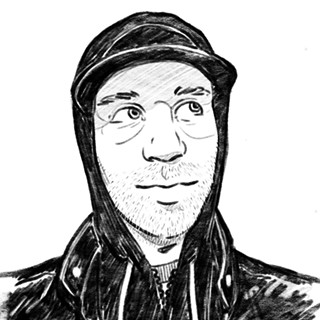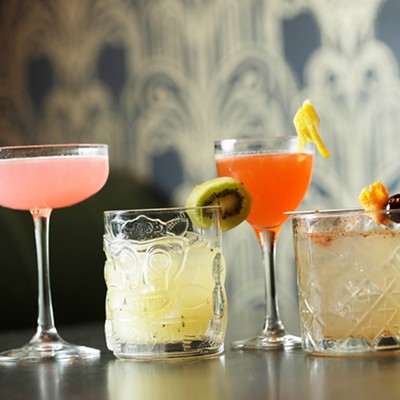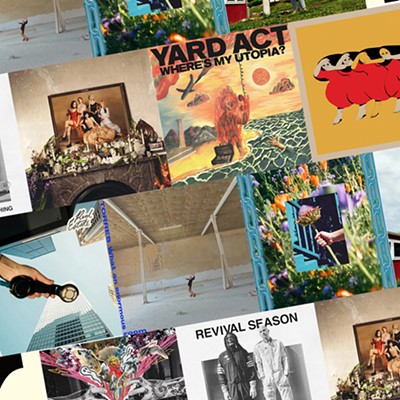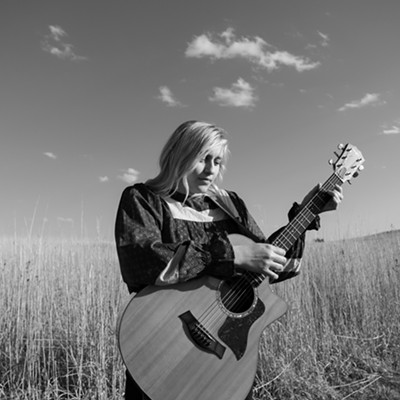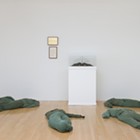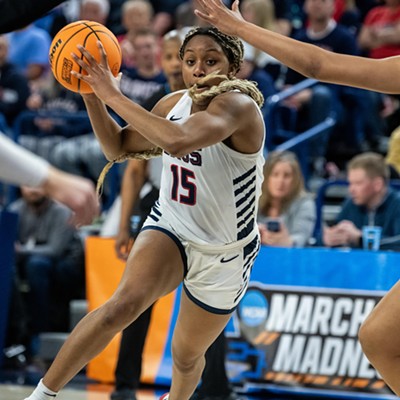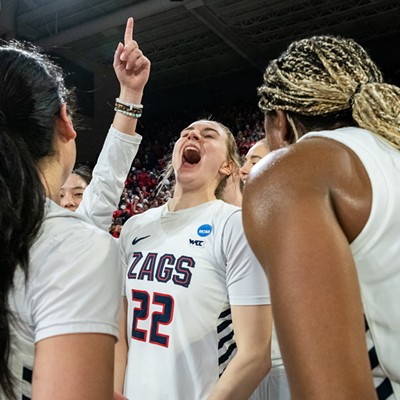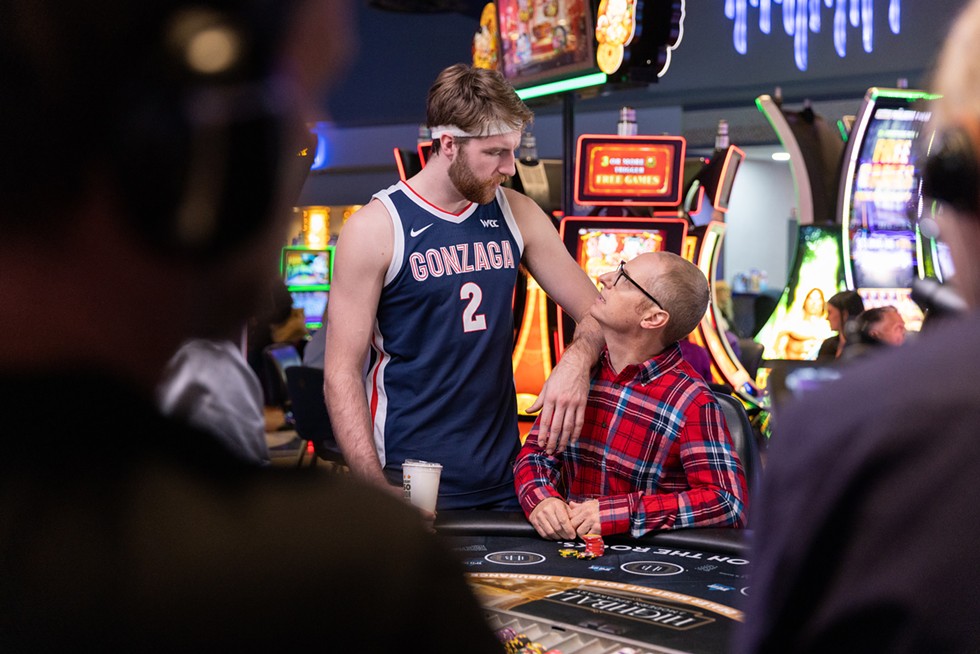
The casino floor is bustling with commotion. Flashing lights and the cacophonous sound of slot machines echo throughout the gaming floor at Northern Quest Resort & Casino, even on a Sunday morning like this.
There's plenty of action: dice clatter off the walls of the craps tables, the digital slots emblazoned with pop culture branding spin on and on, gruff men are getting in their sports bets. It's a glitzy cloud of jackpot hopes and lost bets. Amid this routine bedlam, a small crowd of passers-by are gathering by a cordoned off section of the slots, whipping out their phones to get pics from a distance.
It's not even noon yet, but there — among the casino's weekend regulars — stands Gonzaga All-American Drew Timme. As if the 6-foot-10-inch, bearded Timme wouldn't have stood out enough, he's adorned in his full GU jersey (headband, of course, included).
No, the basketball star isn't there to gamble. But he's the surest bet to come out a financial winner today.
He's shooting another commercial for the casino.
The charismatic Timme has become an advertising star for Northern Quest in the wake of the NCAA passing Name, Image, Likeness (NIL) rules in 2021, which — after decades of only seeing coaches, schools and the NCAA profit — finally allowed student athletes to get paid. The new rules are changing college athletics forever for both superstars like Timme and competitors you've probably never heard of.
There has long been money in college athletics, but the issue has always been who's generating the cash versus who's reaping the rewards. As TV deals and coaches' contracts exploded over the past couple of decades, there was a growing sentiment among fans that the NCAA's pure amateurism model — where student athletes got scholarships to cover tuition, room, board and books, but couldn't get directly paid in any way — was a grossly unbalanced system.
"When I think of the NCAA, that saying 'Pigs get fed, hogs get slaughtered' comes to mind," says Mark Titus, a host of Fox Sports' popular college basketball podcast Titus and Tate and a former walk-on player at Ohio State. "The reason it became a problem is because coaches went from making $1 million a year to making $8 million. And there's a certain point that the general public started seeing how many people are getting not just rich, but like filthy rich, like generational wealth, while the athletes are getting punished for getting a free sandwich. And it rightfully didn't sit well with people."
The major wrench that got thrown in the NCAA's system was the antitrust class action lawsuit O'Bannon v. NCAA. Led by UCLA's Ed O'Bannon, the NCAA Tournament's Most Outstanding Player in 1995, the suit took aim at video games that used these former players' likenesses without compensation. While the games didn't name the players specifically, they had rosters full of players with the correct height, weight, handedness, hair, etc.
The NCAA lost the legal battle in 2014, with finalized affirmations made by the 9th U.S. Circuit Court of Appeals in 2015. Rather than take this as a step toward a new direction, the NCAA essentially shut down all college sports video games.
"At that point instead of saying, 'OK, well we're going to start paying college athletes for their NIL,' the NCAA just said, like, 'All right, let's just kill all the products so we don't have to pay them,'" explains Amanda Christovich, sport business reporter at Front Office Sports who specializes in college athletics.
But then state legislatures started forcing the NCAA's hand. In 2019, California passed a law that said student athletes couldn't be forced to sign away their rights to profit from their name, image and likeness. When Florida passed a similar law that would go into effect on July 1, 2021, the governing body on collegiate sports was left with no choice but to capitulate. On June 30, 2021, the NCAA Division I Board of Directors put in place interim NIL rules. For the first time, student athletes could profit from their marketable profiles.
Getting a grip on NIL's basics isn't an easy task, because the NCAA itself has a bunch of gray areas when it comes to the rules. When talking to experts, people had a tendency to refer to the state of NIL as "the Wild West." While it might be most visible with ad campaigns featuring folks like Timme, USC quarterback Caleb Williams and UConn women's point guard Paige Beckers — or occasionally more headline-grabbing fun deals, like Nebraska wideout Decoldest Crawford doing commercials for an air conditioning company — the implications run deeper than surface level.
For starters, each state has different NIL rules, making it a somewhat uneven playing field. Here in the Evergreen State, there has yet to be any specific NIL laws, but some practices fall under the State Ethics Law. Most crucially, Washington government resources cannot be used to support a third-party business. Essentially, that means public universities cannot act as middlemen to set up deals for student athletes... but private institutions like Gonzaga can. As a result, the athletic departments at Eastern Washington and Washington State University must take an approach of being educators about how the athletes can find deals on their own. This includes programming on topics like networking, etiquette, social media, brand building and finance.
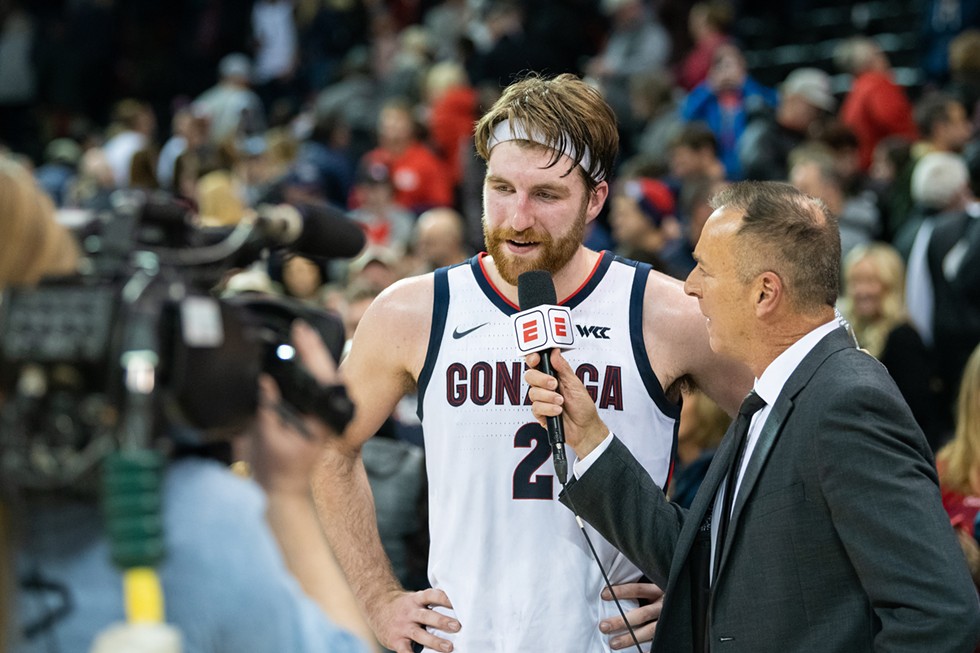
"When NIL was first passed, it was just kind of a free-for-all and follow your state rules. And now the NCAA has given us a little bit more guidance on things that we can follow and directions that we can go," says Nick Garner, director of student-athlete innovation at WSU. "At Washington State, we have about 450 to 500 student athletes, and they could all go about NIL in 450 different ways. And they can connect with their businesses and community members and hobbies and interests and just all different kinds of things that they weren't able to take advantage of in the past. So I mean, everything from trying to start like a book club, because they love to read, to starting a coaching clinic."
One major factor that has emerged since the NCAA opened the door for NIL is the formation of NIL collectives. Particularly at big schools, these groups pool together money from boosters to offer resources to help a school's athletes get more deals. This perputates the traditional major conference school versus mid-major or low-major school power divide. EWU doesn't have a collective, while Gonzaga and WSU have collectives — Friends of Spike and Cougar Collective.
It's also true that for lower level schools like Whitworth University, which competes on the NCAA Division III level, NIL rules are not really a going concern. Maybe there are small deals at certain schools — like athletes tweeting about a local restaurant and getting a bit of free food in exchange — but nothing that has made waves, according to Tim Demant, Whitworth's director of athletics.
"I'm not aware of anything in DIII that's of any significance," says Demant. "My guess is if there was something significant, some of the DIII boards would be all over that."
For the universities themselves, one of the major boons regarding NIL is the stress it relieves from compliance officers — the people who need to make sure the athletes aren't doing anything to make them ineligible because of violations of NCAA amateurism rules.
"I did compliance for 18 years [at WSU and Gonzaga], and it was hard to see some of these kids want to do something so great [but] they couldn't use their name, image and likeness," says Catherine Walker, EWU's senior associate athletic director. "And now that they can, it's pretty special."
Pre-NIL, Walker had to deal with sending out a constant barrage of cease-and-desist letters to people using images of athletes without permission. With his big personality and distinctive mustachioed look, former WSU quarterback Gardner Minshew would've been a star during NIL era, but it was a headache for Walker to constantly have to shut down people for things ranging from T-shirts to the town of Colfax's "Gardner Minshew Days" to handing out mustaches before the 2018 Apple Cup.
"I was on the sideline of the Alamo Bowl when we won," says Walker. "And just the first thought in my mind is like, 'I don't have to send another cease-and-desist letter ever again for Gardner Minshew.'"
"It was hard to see some of these kids want to do something so great [but] they couldn't use their name, image and likeness."
tweet this
Speaking of mustaches, Drew Timme is standing in a hotel casino hallway in the early Sunday morning hours two days after leading Gonzaga to a win over Michigan State on an aircraft carrier. While he runs his lines for his latest Northern Quest ad, the makeup team is covering up scratches on his arm, a result of the physical matchup days prior. Even when the camera's not rolling, you can see why Timme is an advertiser's dream: He's a top performer who is very recognizable, takes direction well, and has the charisma to get the cast and crew laughing at his expense even when the cameras aren't rolling.
"Once we started doing it, you could tell that Drew had a sense of humor," says Mark Robbins, the Spokane actor who's played the hapless husband in Northern Quest's ongoing ad campaign for years and is positioned as Timme's buddy in the commericals. "The hard parts are just sometimes he beats himself up for not being able to keep a straight face through some of the jokes."
Without NIL, Timme might not have even come back to Gonzaga for another season — one that might see him break the all-time Zags scoring record. In an interview with Fox Sports' John Fanta in September, Timme basically said coming back to school was actually the best financial decision for him now that NIL was in place. He said that while he might've made $200,000 to $500,000 this year as a pro, he'll make more than that in NIL deals with brands ranging from national Dollar Shave Club ads to local Walker's Furniture spots.
"I won't get too far into specifics," Timme told Fanta, "but it's going to be more. It will be more than that."
Gonzaga already had a standing relationship with the Kalispel Tribe of Indians, making the initial NIL dealings relatively smooth. For Northern Quest's part, they're already forecasting local athletes that might make sense for NIL deals in future years, including hopefully blending stars from local schools and incorporating female student athletes. They also are trying to set up more in-person NIL deals to get people out to the casino, like an event last year where the GU men's and women's baketball teams were on site for photo-ops with nearly 400 fans. They've also been kicking the tires on retroactive NIL deals, possibly bringing in former Gonzaga greats to hock now-legal jerseys with their names and such.
Naturally, the introduction of NIL has led to agencies specifically focused on working with student athletes. For Drew Timme, the Seven1 sports agency was the obvious fit. Co-founded by former NBA All-Stars Jermaine O'Neal and Tracy McGrady (ironically, both of whom went straight from high school to the NBA instead of playing college basketball), the group is not only based in Timme's home state of Texas, but Timme played for O'Neal's traveling AAU basketball team as a kid, so there was a longstanding relationship prior to NIL.
Seven1 also represents Gonzaga forward Anton Watson, who certainly doesn't have the same national profile as Timme, but is more appealing to some local businesses because he's a Spokane native.
"For Anton specifically, it's refreshing to see how the companies around the Spokane area where he's from have rallied around him to present him with different opportunities. You don't see that that often with student athletes that are born and raised in a particular city and decided to go to that school," says Seven1's Chief Talent Director Deddrick Faison.
With top college athletes transferring more these days or leaving school early to go pro, an established presence like Timme is somewhat of an NIL unicorn. So the offers roll in. Before the season had even started Seven1 had over 20 deals in place for Timme, and it expects even more once the college football season concludes and focus shifts to hoops. Many of those ad campaigns are front-loaded to shoot before the season so as to not interfere with Timme's basketball and class schedule.
"For Drew, specifically, we receive daily opportunities for him at various levels. Some are bad, some are good, some are really, really, really, really bad," says Faison. "That's kind of how you have to differentiate that."
The Timme family itself is also somewhat of an outlier, according to Faison.
"When I say that the Timmes are like a unicorn of this industry, they're very, very together in the things that they do, they're very easy to deal with when it comes to being able to source deals, because we discuss every deal," Faison says. "I source all of our deals through [Drew's mom] Megan Timme, and we discuss them at length almost on a daily basis when they come in. And we come to a consensus.
"The dynamic for college athletics is changed," he continues. "Drew's family, they do pretty well... but there are quite a few student athletes that have come from an impoverished type of situation, and it's 'Am I gonna help my family immediately or can I go back to school?' Even if they want to go back to school, they feel as if they need to take that [pro] deal. Whereas now they can do both. They can still enjoy the college life and go through that process, and then also take care of the family at a certain level."
Timme is actually somewhat of an NIL outlier in one key sense — he's not big into social media.
For most athletes and schools, social media is the first area of NIL focus for student athletes to build their brands and market themselves to companies. Not only is social media promotion an easy way for top athletes to do NIL work without a timesuck, but it also opens the door for athletes who are influencers on their own. University of Miami basketball twins Haley and Hanna Cavinder have parlayed their massive social media following (over 5 million followers across social platforms) to earn north of $1 million over the first 12 months of NIL, despite not being elite level women's college hoops stars. (Which also leads to some uncomfortable topics about how much sex appeal sells with NIL. It is American advertising, after all.)
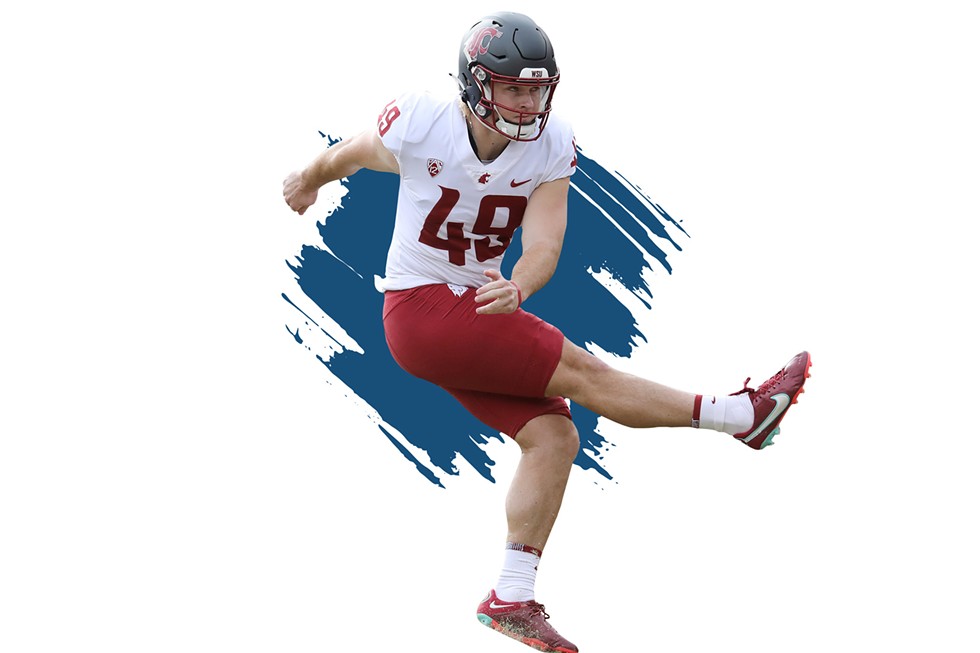
For a local example of an NIL social media figure, look no further than Dean Janikowski, the kicker for WSU's football team. The special teams standout has garnered national buzz for his "More Than a Kick" campaign, which raised money for the Heather Janikowski Foundation, the charity his family established to help children with cancer after Dean's mother died in January 2022 after a long battle with cancer. The campaign allowed people to contribute money based on the number of points Janikowski booted through the uprights this season — raising nearly $18,000.
"Right after the UW game, someone came out and made a comment [on Twitter] about like, 'Why is he celebrating so hard after a field goal?'" says WSU's Garner. "And Dean replied back about how each field goal he makes helps raise money for kids with cancer. And it just really blew up on social media. You had UW fans and WSU fans coming together to help raise money."
And while the NCAA has allowed athletes to be involved in charities prior to NIL's passage, tying money to individual performances — like Janikowski's point total — would've probably fallen into the nonpermissible gray zone, despite being a literal cancer fundraiser.
Janikowski has also been able to make some money for himself based on his social media skills. His TikTok account (@dean.janikowski) has over 51,000 followers and garnered over 1.9 million likes. By doing things like video announcements, posting photos, or doing full-on explanations of products, he's been able to secure NIL deals ranging from local entities to national brands like G Fuel energy drinks and even McDonald's. It also makes him think with a business mindset.
"NIL is fun. I've liked it a lot," says Janikowski. "After doing it for a while, I've sort of figured out kind of like my price point or the actual audience and numbers I can bring to different companies. I've done tracking companies where you put a tracker on your electric dirt bike, and I've been able to bring a few million views to that company."
Finding out how much NIL athletes actually get paid is difficult. With rare exceptions, the dollar figures are kept close to the vest so that both the athletes and businesses have negotiating power in other NIL deals. In November, a University of Arkansas report said that 140 of its student athletes had combined for over 300 NIL deals, earning an average of $4,102. Valuations on what athletes could be worth to the NIL market can be much higher. Alabama's Heisman-winning star quarterback Bryce Young had a valuation of $3.5 million this year, according to NIL valuation site On3, while incoming basketball and football recruits Bronny James (LeBron's son) and Arch Manning (Peyton and Eli's nephew) have valuations of $7.5 and $3.5 million respectively.
NIL isn't going to make the vast majority of student athletes wealthy. For most it's essentially just a part-time freelancing job. And part of the struggle of the new NIL world for someone like Janikowski is simply the time commitment. Over the course of the season he's gotten around 100 NIL offers, but has only accepted around 10 percent of them. After doing school work and taking part in team practices and games, there isn't a massive amount of time to do NIL work.
"Time is the hardest part," says Janikowski of the process of NIL social media creation. "I really strive to make sure I spend a lot of time on it and do it really well and get a lot of views to it, because then it just keeps opening bigger doors. Like I started real small, and then next thing you know, McDonald's was emailing me and asking for deals."
NIL also opens doors for athletes to thrive in ways not connected to advertising dollars. Or really, it's less "opening doors" than breaking down ones that were previously locked for virtually no good reason. In many ways, what NIL really does is allow student athletes to be able to do things that their fellow non-sporting peers could obviously always do. Not only could student athletes not do things like give lessons in their sport or teach at summer camps, they basically couldn't even be entrepreneurs totally separate from their sports.
Former WSU golfer Cami March serves as a perfect example of the unfair pre-NIL standard. As a business-minded student who majored in digital technology and culture, March has an idea to create an app called DWN, which would be a sort of mood ring for activities in your area. The app looks to streamline the hassle of creating plans with friends in a group chat by taking your vibes (energetic, self-care, party, adventure, chill) and matching them with restaurants, activities and event tickets that suit the given mood. But because in the past there had been examples of football players opening fake businesses to funnel booster money to players, it became incredibly difficult for March to start up her own LLC in order to launch her app despite her being a golfer having nothing to do with the product.
"It was just issues with our compliance," says March. "So because of [past shady businesses], student athletes with good entrepreneurial intentions weren't able to create businesses. And so I had to kind of go through a bunch of hoops and obstacles to try to figure out how to stay compliant as an athlete and to make sure that I wasn't, you know, ineligible because of my endeavors. It just took a lot longer than what it would for a regular student, which was just unfair."
While March eventually was able to form YOUDWN LLC, having to jump through the hoops added nearly six months to the process. She's still developing the app and working out the bugs (though it's already been approved for the Apple and Google Play app stores), while at the same time pursuing her professional golf dreams. She even testified about the hurdles NCAA rules had forced her to clear to the House Subcommittee on Consumer Protection and Commerce in September 2021, when it was looking into the new student-athlete rules. For March, the new era of NIL is vital to allow the sort of exploration that college is supposed to be about.
"When you are between 18 and 22, you're still learning a lot about yourself and trying to see what you have access to," says March. "So I think the NIL opportunities will only allow students to further explore who they are, what they're interested in outside of sports, and then being able to have guidance from people that really understand what's going on. I think that's the great thing about NIL — that it doesn't feel like there are things that we can't do because we're an athlete."
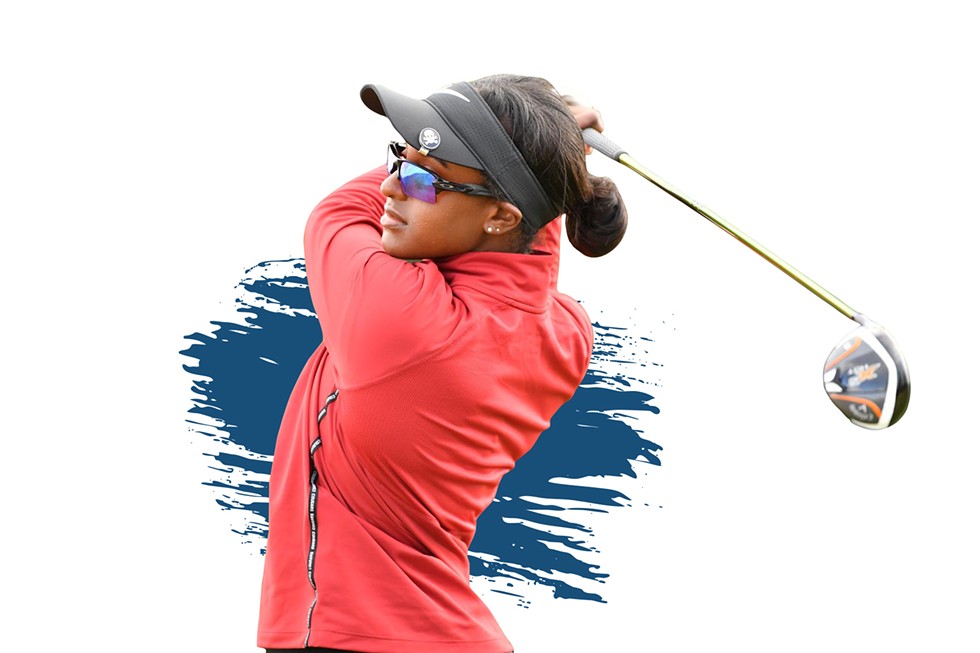
While many have lauded NIL as a step in the right direction for college athletics, there are still plenty of dissenting voices who feel the rules have somehow sullied the integrity of the sports — most specifically college football and men's basketball. While any fan of the sports without their heads buried in the sand knows that boosters have been funneling money to top stars and recruits for generations (often referred to as "bag men" — someone dropping a literal duffle bag full of cash for a star athlete to pick up), some feel the openness of the transactional part of NIL undercuts the former amateurism spirit.
"It's above board bag men in many, many ways," says Christovich of Front Office Sports. "So I guess you could say, it's like the rich getting richer in that sense."
But Chistovich stresses that on the whole NIL seems like a net positive, even if it messes with competitive balance. With only a minute fraction of players going pro in their sport and the NCAA not providing worker's compensation if an athlete gets hurt during competition, NIL maximizes their chance to make money in what might be the peak earning potential era of their entire lives.
"I think it's silly to think that all the players that transfer are doing it strictly just for the money. I think it's a very small, actual number."
tweet this
"I think like some of the fears people had about name and likeness stuff was that the programs that have more money are going to get the best players," says Titus of Fox Sports. "And I've laughed at that notion all along, because has that not been the case up to this point? At a certain point, the economics are gonna take care of itself."
The opening of the transfer portal — essentially eliminating the old rule where athletes had to sit out a year of competition when moving to a new school (a luxury high-paid coaches always enjoyed) — has also raised red flags for purists. Collegiate sports fans might be envisioning doomsday scenarios where a sports fan billionaire — say Indiana alum Mark Cuban — might use NIL to overpay top stars to improve the Hoosiers' hoops teams. But those guys are still capitalist businesspeople, and the idea that someone's going to pay $50 million for an 18-year-old to play hoops is frankly ludicrous fantasizing. And while some top Power 5 conference football programs are certainly enticing for transfers because they offer superior NIL opportunities compared to lower levels, many actually within the sport are skeptical that NIL is really the force behind the transfer influx as much as players just getting frustrated with a coach, seeking more playing time, or pursuing a higher level of competition to test themselves against.
"I think it's silly to think that all the players that transfer are doing it strictly just for the money," says Janikowski. "I think it's a very small, actual number."
Beyond that, the general future of the NCAA seems to be on shaky grounds. With college football being the organization's major revenue source and the commissioners of major conference like the SEC and Big 10 trying to add as many big programs as possible (as UW and WSU Pac-12 fans know, seeing USC and UCLA joining the Big 10), the balance of power could potentially shift away from the NCAA entirely over the next decade.
"The NCAA right now has to be having an existential crisis. I don't really completely understand what their purpose is," says Titus, who points out that the NCAA has always been about two things — maintaining amateurism and putting on tournaments to crown national champions. "And with the amateurism model gone, like half of your identity is gone. So now basically all they do is just run tournaments. And I think at some point — and I think the conferences have already figured it out — you don't need the NCAA to do that."
Beyond the potential power vacuum, there are also cases in the courts that could further upend the NCAA in similar ways to O'Bannon v. NCAA.
"As far as the overall health of the NCAA, I would not be surprised if they didn't even exist in five years," says Christovich, "because there are so many cases winding through the court system that are going after them."
The NCAA recently came out on the winning side of Gee v. NCAA, which was determining if the NCAA was liable for sports injuries — based around the brain damage that led to a former USC linebacker's death. But a current case in Pennsylvania could have even more lasting ripples. Johnson vs. NCAA seeks to declare student athletes as employees of their schools under the laws of the federal Fair Labor Standards Act. A ruling in that case could come within the next few months.
There are also plenty of issues within the NIL space that have not yet been fully addressed as the rules are in their infancy.
"Particularly on the women's side, [there's a] racial bias in earnings for NIL," says Christovich, pointing out that pretty much all the top earning women in the NIL space are White. "And it's like, 'Well, why is that?' And that's complicated to report out because no one is willing to share how much they're actually making. The trends that are happening in the general sort of influencer marketplace or industry are clearly extending to NIL... the gender wealth gap, the racial wealth gap, those sorts of things."
"This is still the American economy," she emphasizes. "We know how it works." ♦
This story has been changed to reflect that Jermaine O'Neal and Tracy McGrady went straight to the NBA after high school.



